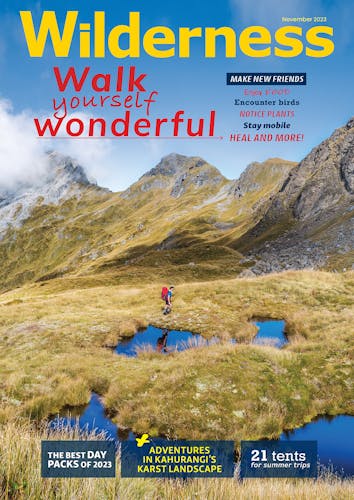Getting to know the plants we see on a walk can help us engage with the natural environment. By Heidi Meudt
A great joy of tramping is being amidst the iconic landscapes of Aotearoa New Zealand. Flax swamps, tussock grasslands, montane beech forests and alpine cushion-fields are stunning backdrops to the most gratifying outdoor experiences. Such landscapes are more than just background scenery; they’re not simply formations, but are comprised of plants – some of the most exquisite and remarkable organisms on this planet.
Aotearoa has over 5500 species of native land plants, each with special characteristics, history, and ecological connections with insects, birds and other species. Many are endemic – they grow nowhere else on Earth – and may only be found in a certain place or be limited to a particular habitat within Aotearoa.
Getting to know New Zealand’s plants can help us understand, and become more connected to, its natural environment.
But first we must simply notice them.
Close your eyes for a moment and picture your favourite tramping spot. Notice some of the plants around you. Start with the native species whose names can be part of the habitat descriptions themselves – these are common species that most trampers will know You may be surrounded by large hummocks of tussock in an expansive tussock grassland; further up, there may be lumpy bumps of cushion plants in an exposed alpine cushion-field.
Notice all the plants collectively in each habitat: how are they distributed across the landscape? Are there hundreds of plants covering the area, or just a scattered few? Is there variation in plant size, shape, colour, texture, scent?
Now choose one individual plant. Perhaps it is a large tuft of a common species, such as the red tussock grass (Chionochloa rubra). Or perhaps an alpine cushion plant, which could be one of several different species including vegetable sheep (Raoulia rubra), a snow hebe (Veronica thomsonii) or a forget-me-not (Myosotis pulvinaris). Look closely at this plant’s special characteristics. Note its size and form, and its leaves. Notice the colour, shape and arrangement of the flowers (yes, tussocks and many cushion plants are flowering plants: see if you can spot the clusters of drab grass flowers or the white star-like flowers of the snow hebe). Feel the leaf texture – is it rough, flexible, or perhaps hairy? Is there a scent?
Perhaps you’ve seen this plant in another place? Do you know its name? Do you know anything about its history, whakapapa or ecological relationships?
By first noticing the plants along a track, trampers can begin to learn their names, understand how to identify them, and figure out their ecological connections and where they live. You could draw or photograph the plants; describe them in your tramping diary, and compare your observations to those in field guides and other online resources.
These additional, advanced ways of noticing plants can lead to new discoveries and fresh insights, as well as a deep sense of satisfaction, appreciation and wonder. And by uploading your observations and images to iNaturalist.nz, you can learn plant names, keep an electronic inventory of tramping discoveries, and make valuable community science contributions to online databases that inform scientific research.
On your next tramping trip (or even your next visit to a park or garden), make sure to take time to look – really look – at the plants around you. The everyday wonder of noticing plants may completely amaze you.
– Heidi is the curator of botany at Te Papa







